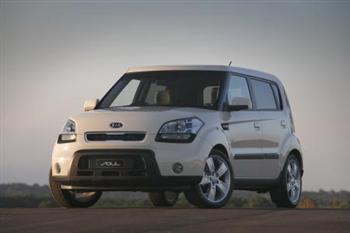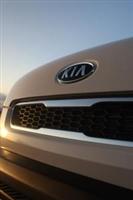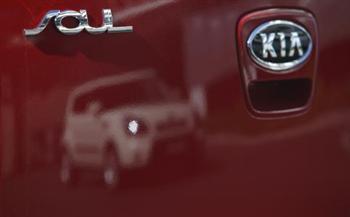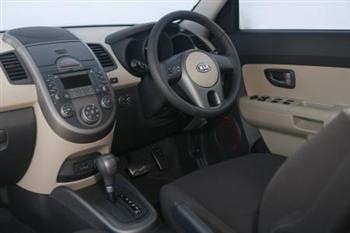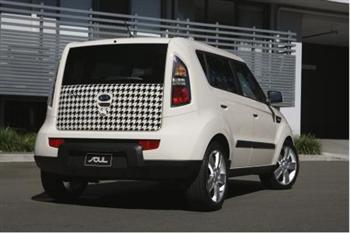|
Home | News | Road Tests | ||||||||||||||||||||||||||||||||||||||||||||||||||||||||||||||||||||||
All-New Kia Soul Released Locally
OVERVIEW The eagerly awaited all-new Kia Soul marks a revolutionary expansion of the Kia product line-up and redefines the 'personality' of cars, with the so-called Generation Y and the young-at-heart firmly in its sights. Kia Soul presents consumers with such a broad selection of styling, comfort and equipment choices, that it redefines the concept of freedom and individuality and potentially provides a new category for the young and young-at-heart. It's a brand new urban car packed full of liberating ideas - a car that challenges consumers to 'free their minds', to build an emotional bond with their new car and to rethink everything they know about Kia. The all-new Soul closely follows the concept car first shown to the world in 2006. Kia Motors Corporation's Chief Design Officer, Peter Schreyer, has overseen the evolution of Kia Soul from 2006 concept fantasy to its 2009 production reality. "Conceived in the USA, developed in Korea and fine-tuned in Europe, the Soul will be a breakthrough vehicle for Kia on its journey to be seen as a design-led company and the maker of distinctive cars which consumers aspire to own," said Mr. Schreyer. "Kia Soul is all about creating a car that demonstrates our passion for automotive design, gets Kia talked about the media and the public, and generates an irresistible customer appeal." The Kia Soul also features the trademark Kia 'corporate grille' designed by Schreyer that first had its Australian premiere on the new Kia Cerato sedan, launched in January this year and already drawing accolades from the Australian media and buying public alike. Available in three different grades - Soul, Soul2 and Soul3 - the key to the all-new Kia Soul's appeal is its ultimate 'customisability' for young and young-at-heart urban car buyers. With 30 customisable accessories and three option packs available, no two Souls seen in the street are likely to be the same, thus expressing the individuality of their owners. The new Kia Soul can be whatever you want it to be! Options range from alloy wheels; body-kits; audio upgrades; red 'street demon' or beige 'retro chic' interiors; body accents and many other options, all designed to offer customers almost infinite possibilities to customise and individualise their own Kia Soul.
While new car buyers want vehicles that reflect positively on them as owners and fulfil wide-ranging applications, younger buyers from Generation Y want cars that allow them the freedom to express their individuality. In the minds of Generation Y, cars need to perform, only lightly touch the environment, look good, deliver on safety, be reliable and be well-appointed..."but everyone must know that this is my car". Kia is bringing a range of new and revamped models to the Australian market this year, well-endowed with features, stunning looks and impressive value for money - in essence, cars that deliver on their promise. According to Schreyer, it's no surprise that design is the No.1 purchase influence but it is essential that new designs match both the Kia brand value and the vision of the Kia brand - "exciting and enabling". As head of design, Schreyer has worked to develop a new, more contemporary look for all Kia vehicles, and he has definitely succeeded in the case of the new Soul. Indeed Soul became the first Korean car to receive the prestigious recognition of a design award from the world-renowned 'red dot' awards at the 2009 product design competition held recently in Germany. Like all new Kia vehicles now sold in Australia, the new Kia Soul will be covered by the peace of mind offered by Kia's 5-year/unlimited kilometre warranty for private buyers (5-year/130,000kms for fleet buyers). All-new Kia Soul - "no two Souls are the same". DESIGN It's new. It's different. It's a car with Soul Emotional. Iconic. Self-confident. Bold. Lifestyle-driven. Simple words which, when added together, start to capture the 'personality' of Soul - the new, almost impossible-to-categorise small car from Kia. Soul is a car all about freedom - freedom to stand out from the crowd through its unique design and personalisation options, freedom of the open road thanks to its fun-to-drive character, and freedom of lifestyle through an expressive interior and a seating arrangement which offers the flexibility of a medium-sized MPV or SUV within the footprint of a light car. Soul is an urban crossover - small enough to be ideally suited to the world's urban jungles, but totally different to conventional, workaday small cars. By combining charm and desirability, with a hint of SUV ruggedness, Kia is opening up an entirely new market sub-segment with a car that will win the hearts of the young and the young-at-heart. What is it? Five doors. Five seats. Front-wheel drive. Just over four metres long. Hatchback rear. That description could apply to any entrant in the light car B-segment car, but within those parameters Kia has manufactured a car that defies conventions, bonds with its owners and opens up a world of possibilities: Soul. "For our customers, it's a lifestyle statement," says Kia Motors' Chief Design Officer, Peter Schreyer. "It creates a strong emotional link between them and us. It will be our first car where customers will check the colours and accessories before they check the price. It is our accelerator for an image shift towards design." Anyone who was at the Detroit Motor Show in USA in January 2006 will remember the 'stir' evident when Kia unveiled the Soul concept car. For many people, it 'stole' the show. If Kia ever had any doubts about the potential market for a production Soul, critical acclaim at Detroit banished them. That original concept car was the inspiration of Kia's North American design studios in California, led by Tom Kearns. Eight months later, when Peter Schreyer became Chief Design Officer, he was full of enthusiasm for Soul and has personally overseen the project to the production stage. So, while engineering design teams in Korea - where Soul is now being made - continued the detailed work of preserving as much of the concept car as possible for the production model, Kia's European designers in Frankfurt under Gregory Guillaume, chief designer for Kia Motors Europe, were fine-tuning how it would look and drive. Their Soul Burner, Soul Diva and Soul Searcher concepts appeared at the Geneva Motor Show in March 2008, and though nobody was to know it at the time, they strongly hinted at the customisation options and marketing initiatives Kia was planning for the production Soul.
In October 2008 Peter Schreyer unveiled the production car at the Paris Motor Show with words of praise for the foresight of his colleagues in California two-and-a-half years earlier. "Detroit 2006 marked a special point in time for Kia Motors," he said. "Very few people, even those inside Kia, realised what a big moment it was when the Soul concept appeared on stage. It looked like a flight of fancy...until now." The real thing Soul was designed to take advantage of a new and extremely flexible platform which will also be used for future Kia models, so the core proportions of the Detroit 2006 concept car have been retained for the production car. What is perhaps most remarkable is the extent to which the look of that concept has also been kept. This has at times involved some tough bargaining between designers and other departments, especially those whose job it was to keep down production costs. The glossy black cover over the A-pillars and the coatings over the B- and C-pillars, designed to make it appear as though the windows curl around most of the car in one unbroken arc, are twice as expensive as a conventional treatment. In the end, though, the designers convinced everyone this was necessary to convey the character of Soul. The black bezel around the front lamps and the double-lens rear combination lamp units were also approved for production cars, as were wheels of up to 18-inches, though the designers had to reluctantly accept that the concept car's multi-folding tailgate, profiled to look and be as practical as a 'backpack', would have made the production model too expensive for customers. The tailgate design element was retained from the early design sketches and underlines practicality and reflects the urban nature of the Kia Soul. However, the 'backpack' shape for the tailgate has been retained, albeit with a much flatter profile to enable customisation to the buyers taste. At 4.1 metres long, Kia Soul barely differs from the majority of cars in the light segment, although it does have an unusually long 2.55 metre wheelbase. The key to its striking appearance are its vertical measurements. It is just over 1.6 metres tall, the base of the windscreen is 135 mm higher than that of a typical compact car and the ground clearance is 45 mm greater. Together, these raise the hip point of front occupants by 120 mm and give Soul something of an SUV's commanding seating position. A high bonnet with rounded forms implies power and strength, while bulging wheel arches and a wide track give the car a broad stance that heightens its sense of stability. Large headlamps, Schreyer's 'Kia corporate grille' and the prominent centre bumper give Soul a 'tough, but not rough' appearance. Soul is the second Kia model launched in Australia to receive Schreyer's new family grille, following hot on the heels of the all-new Cerato launched to some acclaim in January at the Kia sponsored Australian Open tennis competition. The profile of Kia Soul is highly distinctive. Boldly protruding wheel arches joined by a body side-crease visually lower the car, while the roofline, although almost horizontal, appears to slope gently down to the tailgate. This line is uninterrupted as the door tops do not intrude into the roof panel. The beltline, which rises from the front wheel arch to provide a gentle wedge shape, is continued under and around the third side window. Whilst incorporating the side repeaters, a decorative air vent in each front guard abuts the beltline to intensify an image of quality. The rear is dominated by vertical combination lamps set into a body colour panel and featuring clear outer lenses. One of the early "concept" sketches which helped to define what Kia Soul was all about featured a wild boar. With its strong, wide 'shoulders', a determined look in its eyes and distinctive sloping back, this animal has one extra, and unusual, attribute - a practical backpack. The rectangular tailgate reflects that backpack "profile", a design element which has remained since those early inspirational designs which included the 'wild boar' - it underlines practicality and reflects the urban nature of Kia Soul. It was best seen on the Soul concept car at Detroit where the tailgate opened a number of different ways providing flexibility of use. The body side and wheel arch crease line extends around to the bumpers, which are broken by SUV-style 'tusk' bumper panels in a contrasting colour to the rest of the body work to further the 'tough, but not rough' appearance of the car.
POWERTRAIN Engines Soul is available with Kia's refined and ultra-reliable 91 kW 1.6-litre petrol and 94 kW turbo diesel engines. Both deliver excellent driveability and efficiency. Both engines are Euro-4 compliant. The 1.6-litre U2-series CRDi engine was designed and engineered at Kia's 'centre of diesel excellence' in Russelsheim, just outside Frankfurt (Germany). It is a twin overhead camshaft unit with four valves per cylinder, common-rail high-pressure fuel injection and a variable geometry turbocharger (VGT) which adjusts the flow of exhaust gases in order to ensure optimum performance throughout the rev range with maximum fuel economy and low CO2 emissions. A diesel particulate filter is fitted to the automatic version. With 260 Nm of torque peaking at just 1,900 rpm and peak power of 94 kW at 4,000 rpm, the CRDi engine ensures excellent flexibility and open-road performance. Under the official ADR81/02 combined consumption test, the Soul diesel can achieve up to 5.2 litres/100 kms (manual transmission) and 5.9 litres/100 kms (automatic). This gives the diesel Soul a potential combined cycle range of up to 923 kms from a single tank of diesel. Its CO2 emissions are just 137 g/km with the standard five speed manual gearbox and 155 g/km with the optional four-speed automatic. The new all-aluminium 1.6 litre Gamma series petrol engine, seen here in Australia for the first time, develops 91 kW at 6,300 rpm, with 156 Nm of torque at 4,200 rpm. Like the diesel engine, it has twin overhead camshafts, four valves per cylinder and features electronic multi-point fuel injection and continuously variable valve timing. Emissions are an effective 154 g/km and ADR81/02 combined economy is 6.5 litres/100 kms for the manual, giving it a potential combined cycle range of up to 738 kms from a single tank of 91RON unleaded petrol. With a kerb weight starting at just 1,254 kg, Soul enjoys an impressive power-to-weight ratio for a B-segment car with so much interior space, flexibility and equipment. Even more impressive is the 5-star rating - yes, 5-star - of the petrol-engined Kia Soul with manual gearbox in the Australian Government's Green Vehicle Guide. Kia's latest range of new releases is making quite a splash in the Green Vehicle Guide with the all-new Cerato, released in January this year, being awarded a 4.5-star GVG rating. Transmissions The standard gearbox in Kia Soul is a five speed manual based on that used in Europe's Kia cee'd but with revised ratios for the 1.6 litre petrol model. For Soul, its weight has been reduced and shift quality has been enhanced by reducing friction and fitting a new type of poppet ball and rectilinear bearing. Reverse gear has also been moved to the upper left of the gate to make it easier to select after first lifting a collar around the lever. Double- and triple-cone synchronisers as well as a concentric slave cylinder delivering improved clutch pedal response also improve shifting efficiency and smoothness. Ratios have been optimised to suit the characteristics of the different engines and ensure maximum driveability with minimum fuel consumption and emissions. Only the second-gear ratio is shared by petrol- and diesel-engined variants. They also have specific final drive ratios. The optional four-speed automatic gearbox is an 'intelligent' system governed by an electronic controller which monitors several parameters to ensure smooth shifting at all times, taking into account individual driving styles and adapting as it 'learns'. Several perfectly-harmonised features have been incorporated to give it a sporting shift capability. These include a thicker gearbox casing and a disc-type return spring to prevent wear and tear. CHASSIS The Kia Soul is every bit as good to drive as its appealing styling suggests. It delivers agile and precise handling on twisting roads, excellent high-speed stability and easy low-speed manoeuvrability. The all-new Kia Soul has a relatively long wheelbase and wide track for its class size, with inherent benefits for stable handling and a comfortable ride, and features fully-independent strut-type front suspension with coil springs and gas-filled dampers and a torsion-beam rear axle with trailing arms, coil springs and gas dampers. Anti-roll bars are fitted front and rear to minimise body sway and ensure maximum stability when cornering or making sudden lane-change manoeuvres. Both front and rear suspension systems are mounted on subframes with isolating bushes to curb noise, vibration and harshness (NVH) and help provide the best ride-and-handling balance. The front MacPherson struts have co-axial coil springs, offset to reduce friction. Offset kingpin geometry and a four-degree castor angles enhance stability and ride comfort while allowing the driver to steer with minimal effort. The geometry guarantees minimal castor and camber angle changes so the car remains stable under all conditions. The anti-roll bar is mounted directly onto the damper to ensure maximum control of sideways body motion when cornering. The compact rear suspension helps provide outstanding ride comfort with minimal intrusion into the luggage area. The coil springs and dampers are mounted separately to ensure smooth operation; the hub bearings are designed for maximum durability and have urethane stops to improve refinement. An anti-roll bar is packaged within the torsion beam to save space. Kia Soul is based on an all-new platform that provides excellent torsional stiffness - with clear benefits in terms of ride quality, handling, refinement, durability and safety - and a huge degree of production flexibility. The same platform will be used in modified form in other future Kia models. The body shell makes extensive use (70 per cent) of high-strength steel in structurally-critical areas. This saves weight without compromising stiffness. Finite element analysis in simulated crash testing led Kia engineers to strengthen several areas, including the front bulkhead joint with the A-pillar, three floor cross-members, the roof joints with the A- and D-pillars and the four corner pressings on the tailgate. The result is a car that surpasses Kia's stringent internal targets for twisting and longitudinal rigidity - in short, it's a refined car. To ensure Soul provides low internal noise levels with minimal vibrations, the engineering team added a number of features to reduce engine idling noise, and further measures to mute road noise over poor road surfaces and a vibration damper on the longer right-hand driveshaft. They also modified the exhaust silencer, window and door sills, floor pan insulating pads and the soundproofing on the windscreen header rail. Soul has exceptionally low levels of NVH (noise, vibration and harshness). Kia Soul has motor-driven electric power-assisted steering that typically gives 3 per cent fuel savings over a conventional engine-driven rack-and-pinion system. Power assistance is provided only when needed, reducing pumping losses on the engine the rest of the time. The steering ensures precise handling with good high-speed feedback and effortless low-speed responses, such as when parking. It requires just 2.7 turns from lock-to-lock for a tight turning circle of 10.5 metres kerb-to-kerb. Wheels of 15-, 16- and 18-inches in diameter are fitted, with tyre profiles varying from 195/65 to 205/55 to 225/45, depending on model. The spare wheel is a steel space-saver. Soul is fitted with 280 mm ventilated front discs and 262 mm solid rear discs on Soul2 and Soul3 (203 mm rear drums on base Soul) so that the car is brought to a stop quickly and effectively with maximum pedal feel. The anti-lock brakes rely on a four-channel, four-sensor system honed to deliver fade-free operation and the highest safety, even under the most severe use.
INTERIOR Lots of cars aspire to be 'fashionable' and 'different' with their exterior styling, but fail to carry that through to the interior - the area where owners actually spend time. Kia has not fallen into the same trap with Soul. From the colour schemes and trim choices to the personalisation options, audio systems - and even safety features - Soul ensures that what is promised on the outside is delivered inside. Owners can virtually 'design' their own unique Soul through the accessories that are available either as factory-fit options or though the Kia dealer network. Kia has not forgotten that owners not only want a car that looks good, but also one that fits their lifestyle. The unusually long 2.55-metre wheelbase and high 1.61-metre roofline guarantee excellent access and genuine five-person space within a compact 4.1-metre overall length. This passenger space doesn't come at the expense of luggage capacity. Soul typically offers 340 litres of cargo space, rising to 800 litres with the rear seats folded. Gregory Guillaume, chief designer for Kia Motors Europe, says: "First impressions will make a big impact. There are several unique aspects to the experience of sitting in a Soul. The tall doors and high-mounted seats make for easy access, while the laid-back dashboard, triple-dial instrument cluster and thick-rimmed steering wheel create an unusual combination of spaciousness for passengers and comfort for the driver." "The Kia Soul gives customers the freedom to enjoy multiple choices and to create their own interiors and achieve a degree of personalisation that is not often possible in high-volume cars." SUV driving position The first thing drivers will notice, particularly those downsizing from an SUV or MPV, is the commanding driving position they have become used to. The hip point of the driver's seat is around 120 mm higher than in a regular B-segment car, while ground clearance is 45 mm higher and the base of the windscreen is around 135 mm higher. The cockpit is neat and sporty, with a thick-rimmed four-spoke steering wheel and a three-dial instrument cluster beneath a tightly-curved cowling. The instruments, with sporty red LED illumination, are made up of a large central speedometer with a rev counter on one side and fuel and engine temperature gauges on the other. The switchgear and control layout is based on sound ergonomic principles as well as eye-catching design, dominated by a centre stack that appears to float beside the driver. In Soul, it is laid back over the dash and houses the audio system, air conditioning controls, a storage area and, depending on model, an additional speaker. The air vents on the outer edges of the dash echo the shape of the centre stack and are 'crowned' by a pair of tweeters that are standard on every model. Living space Small on the outside; big on the inside - it's a claim made for lots of cars, but with Soul it's actually true. Despite being 210 mm shorter and a class size below that of the Nissan Dualis, Soul has very clever engineering and packaging which enables it to have more front and rear legroom and more rear head and shoulder room. In direct comparison to the Suzuki SX4 hatch, the Kia Soul has more leg, head and shoulder room. But that's just part of the story. Soul is so spacious, even with five people aboard - and they can easily get in and out. The rear seats are split 60/40 and fold almost flat without the need for the head restraints to be removed. In five-seat mode the boot can accommodate a golf bag plus two travel bags, while with the rear seats folded, two 26-inch mountain bikes will fit in. In-car storage space is just as impressive as that provided by the regular-shaped rectangular boot. There are up to 14 zones where items can be stashed, depending on model. They include a two-tier glove box and a larger open circular tray on models without the optional centre speaker. The centre floor console has spaces for a mobile phone and other small items and contains a large cup holder and an open compartment big enough for a 1.5 litre bottle. Both front doors can accommodate a half-litre bottle plus maps or other documents and there are spaces for two more 1.5-litre bottles (with retaining straps) in the luggage area. An underfloor storage tray is fitted in the luggage area of Soul3 models. Audio In keeping with Soul's rebellious, individual and urban character, Kia has ensured that every model has a high-end audio system capable of being linked to digital music players or other portable music devices. Indeed, the interior design was heavily influenced by the audio systems Kia has chosen. The audio system features PowerBass - psychoacoustic technology that overcomes the inherent difficulties of delivering good sound in a challenging environment such as a car. The result is concert hall-quality sound with a lively reproduction of bass tones. Every model has a six-speaker radio with CD player, MP3 compatibility and USB and AUX ports, and iPod (R) compatibility using an optional link-cable to enable the car to be hooked up to Apple's iconic digital music player. The volume control is automatically adjusted to take account of the car's speed. Soul2 and Soul3 gain steering wheel-mounted remote audio controls, while Soul3 has an upgraded 315-watt external power amplifier with dash-top centre speaker, a boot-mounted sub-woofer and mood-reflecting LED lights within the front door speakers. These lights can be set up to give static light, auto dimming and brightening at two-second intervals or to pulse in time with the chosen music. They can also be switched off, while the level of LED brightness is adjustable. SAFETY The new Kia Soul range continues Kia's commitment to offering safety and value across the whole Kia range. The Soul range is equipped as standard with dual SRS front airbags; side front SRS airbags and full-length curtain SRS airbags; active head restraints and seat belt pre-tensioners for front seats; and 4-wheel disc brakes with ABS (Anti-lock Braking System), EBD (Electronic Brake force Distribution) and Brake Assist. Soul2 and Soul3 come standard with ESP (Electronic Stability Programme) and TCS (Traction Control System). ABS brakes allow drivers to maintain steering response and directional control even when braking heavily, minimising the risk of an accident. Electronic brake force distribution adjusts the force applied to individual axles. Active safety Kia is becoming recognised worldwide for its continuing commitment to making its vehicles more able to avoid accidents, as well as making its cars a safer place to be should they become involved in accidents. ESP intervenes to prevent skids by braking one or more wheels, reducing engine power or both if sensors detect the car may be about to go out of control. EBD, meanwhile, automatically ensures stopping power is directed to each of the four wheels in such a way as to ensure the car is brought to a halt in the shortest possible distance. Braking pressure is reduced on those wheels with least grip and increased to those with the most grip. Passive safety Should an accident be unavoidable, occupants are protected by a remarkably stiff and strong body and a full package of SRS airbags. Dual SRS front airbags, side front SRS airbags and full-length SRS curtain airbags are fitted as standard on every new Soul. Active head restraints maximise neck protection in the event of a collision. Every new Soul has a three-point safety belt for all five seating positions, ensuring every occupant is safely restrained in the event of an accident. Complementing Soul's array of safety equipment, thicker gauge steel has been strategically used in key locations to provide a stiffer body shell without adding unnecessary weight, to protect occupants in the event of an accident while at the same time minimising unnecessary fuel usage. Crash safety Kia has engineered the Soul with safety in mind since the time it was nothing more than a sketch. Internal testing, development and computer simulated crash testing has shown that Soul is capable of achieving a five-star EuroNCAP rating. However, this will not be confirmed until Soul is independently tested by EuroNCAP during mid-2009. EQUIPMENT 'No two Souls are the same' Available in three different grades - Soul, Soul2 and Soul3 - the key to the all-new Kia Soul's appeal is its ultimate 'customisability' for young and young-at-heart urban car buyers. The name 'Kia' has become synonymous with a reputation for strong levels of equipment matched with great value, and the Kia Soul range is no exception. The Soul range offers a comprehensive package of standard specification in all models, as well as traditionally low running costs and a comprehensive 5-year/unlimited kilometres warranty package for private users (5-years/130,000 kms for business users). The main features of the Kia Soul include:
Kia Soul2 - same as Soul, plus:
Kia Soul3 - same as Soul2, plus:
Personalisation Every Soul sold has the potential to be as individual as the person buying it - "no two Souls are the same". A list of options and equipment packs ensures buyers can tailor the car exactly as they want it, reducing the chance that they will see another car exactly the same. For added value, Kia has put together a series of option packs which will allow personalisation at extremely affordable rates. WARRANTY The all-new Kia Soul range comes standard with the confidence of Kia's new 5-year/unlimited kilometre warranty for privately registered vehicles (5 years/130,000 kilometres for business and commercial vehicles). The five year warranty, better than almost every other new factory warranty available in Australia, reflects the rapid improvements to the quality and reliability of Kia vehicles in recent years. The balance of the five year warranty is fully transferable to a new owner should a new Kia Soul be sold during the warranty period, further enhancing the vehicle's value. PRICING (RRP) The all-new Kia Soul range offers a high level of standard specification and value across every model.
Optional: Premium paint is available at $400 extra cost.
MANUFACTURING Gwangju plant refurbished to produce Soul Kia is able to build up to 175,000 Souls a year in Korea and China. The Korean plant can turn out a maximum of 135,000, with the remainder being assembled within China specifically for the Chinese domestic market. All versions of Soul for the Australian market come out of Kia's most recent domestic production facility - and one of its most flexible - at Gwangju. The Gwangu plant has been extensively refurbished for Soul, even though it has been a Kia factory only since 1998, when Kia was acquired by parent company Hyundai. The upgrade allows the plant to deliver even higher quality and gives it greater production flexibility to accommodate the multiple Soul derivatives that are planned during the model cycle. Gwangju also produces K-series trucks, buses and military vehicles, as well as the Sportage compact SUV for markets outside Europe. The plant employs 7,000 workers and has an annual capacity of 420,000 vehicles. Knock-down (KD) vehicles are also made there for assembly outside Korea. It is a highly profitable plant that now has facilities to match any in the world. It is also a strategic export base for Kia, and as with all Kia factories, great efforts have been made in recent years to reduce its environmental impact. The plant has adopted a zero-landfill scrap disposal system, increased robotisation in its painting facilities and gone over to totally soluble paints, introduced a separate waste collection system to minimise wastage and even added solar heating for its hot water, all with the aim of reducing energy consumption and the CO2 output of the plant. Kia has made reducing the amount of raw materials being fed into the production process a major priority in each and every production facility around the globe. The last few years has seen significant progress in reducing waste, increasing recycling and developing cleaner production processes. The overall waste generated by Gwangju is under constant review and a number of programmes have seen dramatic improvements. Despite providing a greater number of larger, more complex and more crashworthy vehicles, the waste remains constant at around 5.1 tons per vehicle. This may sound like a large amount, but we should bear in mind that Gwangju produces mainly military trucks, large buses and trucks. Exhaust pollutants from Gwangju have also decreased dramatically - dust output has been reduced by a third in just six years - and new technology is playing a significant part in environmental improvement. Typical cast melting furnaces produce large amounts of dust and contained within this is a high proportion of zinc. The captured dust is treated and the zinc extracted before being re-used within the production process. In another area of Gwangju, a direct fired steam air conditioning system has been introduced. Unlike conventional systems that need fuel to supply heat after converting to steam, these systems transfer heat directly from the fuel/heat reservoirs within the plant to indoor rooms. This system has proven to be remarkably efficient and saves around 21,000,000 Korean Won - AUD21,650 - annually. More importantly, this corresponds to around 107 tons of CO2. The green landscape around each facility is an important part of each plant make-up. One ongoing programme is based on a number of 'ecology gardens' which are filled with trees and plants resistant and sensitive to environmental changes in air pollution. The Gwangju plant is no different with more than 88,300m2 of green areas and 98,100 trees planted in and around the facility. Almost 14.5% of the factory plot size is given over to green areas. This has the added benefits of providing a more comfortable environment for the staff and local population and offsetting some of the CO2 output from the facility. These 'ecology gardens' are continually monitored as they act as a real-world indicators to air quality. Each site is broadening its green patches in and around its compound and is constantly monitoring air pollution in neighbouring communities. A monthly task for each facility is the 'One Stream Clean-up' programme, where Kia staff clean and maintain local, natural streams. This is not only to monitor their cleanliness but also to keep them well maintained for the local communities to enjoy. The overall effect of the many 'green' initiatives - reducing the use of raw materials, recycling more and reducing waste - has resulted in Gwangju being officially recognised as an eco-friendly worksite by the Korean Ministry of the Environment. | ||||||||||||||||||||||||||||||||||||||||||||||||||||||||||||||||||||||
More Kia News ..... here About | Car Clubs | Home | News | Road Ramblings | Road Tests | Subscribe | Top Drive © 2009 All rights reserved. Next Car Pty. Ltd. | ||||||||||||||||||||||||||||||||||||||||||||||||||||||||||||||||||||||

